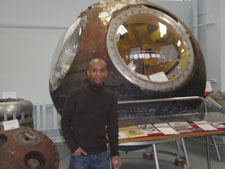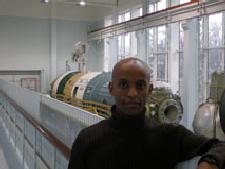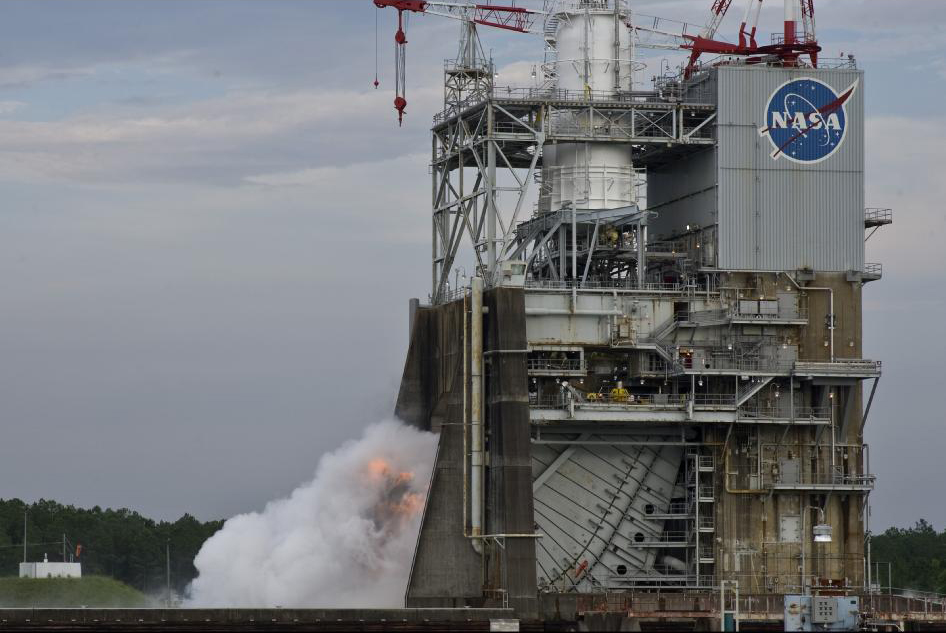May 10, 2011 Vol. 4, Issue 3
Lealem Mulugeta’s journey from Ethiopia to NASA has led him to reimagine the future of space exploration as one in which anyone can participate.
Ethiopia to Canada
Born in Ethiopia, Lealem Mulugeta, was always picking things up and handling objects. “There was this side of me that was very creative and needed to build stuff,” he said. Growing up, he used to watch his father, an electrician and mechanic in the navy, work around the house and imitate what he did. His father hoped he would become a doctor, but his true passion was flight. “That was the one thing that always fascinated me,” said Lealem.

Lealem Mulugeta standing in front of Yuri Gagarin’s capsule in Moscow, Russia. Photo courtesy of Lealem Mulugeta.
Lealem and his family moved to Canada when he was eleven years old. He planned to study medicine, but found he couldn’t shake the allure of flight. “I started reading about spaceflight and different kinds of aerospace projects,” said Lealem. “I found that aerospace engineering was the [field] that combined all of my talents into a nice package,” said Lealem. He enrolled in the newly formed mechanical-aerospace engineering program at the University of Manitoba. While studying engineering, he trained as a competitive gymnast and worked as a research assistant in a metallurgy laboratory where he helped conduct research related to material processing in microgravity.
During this time he also got involved in Mars analogue research with the Mars Society of Canada. He “flew” two missions, one of which he commanded, another where he was an engineer. “When I went through all of that I discovered I was really interested in engineering, but I also had this fascination on the human aspect of it.”
This led Lealem to pursue an interest in spacesuit design. The field offered many challenges related to materials technology and had the added bonus that his medical interests were applicable. “That’s really where I merged my engineering background and my interest for space life sciences together.”
Canada to France
Lealem wanted to work in human spaceflight, but his path was unclear. He considered a master’s in metallurgical engineering, but decided his heart wasn’t in it. Instead, he started working on mechanical design for a local aerospace company that developed satellite and aircraft hardware. He gained experience as a lead engineer on a small project with the satellite division and transitioned over to aircraft work, but it wasn’t spacesuits. “Everything I did there, I focused all of my design experience towards how I could transfer it to spacesuit design,” said Lealem. After a while, Lealem decided that he wanted more and left for France.

Lealem Mulugeta performing an EVA at the Mars Desert Research Station in Utah. Photo courtesy of Lealem Mulugeta.
He went through the one-year master’s program at the International Space University in Strasbourg, France. The program supplemented his technical knowledge while also fostering the ability to follow his curiosity about space life sciences. “The internship was a gateway for me to access experiences that I would have otherwise not had access to.” This included multidisciplinary work, cross-cultural experiences, and an internship opportunity with the EVA Physiology, Systems and Performance Group at Johnson Space Center in Houston, Texas, where he gained experience and expanded his network.
After his coursework and internship were complete, Lealem returned to Canada for eight months to perform independent research. He took it upon himself to publish as much as he could, which turned out to be five papers within that timeframe. The time also allowed him to reconnect with people he had met in Houston. It was only a short time before they invited him to come down and work.
Mooers Law
Lealem achieved what he had wanted since he was a boy: space, engineering, and life sciences all in one job. He currently works for Universities Space Research Association (USRA) as the project scientist for the NASA Digital Astronaut Project (DAP).
The DAP develops and implements computational physiology models to beneficially augment research to predict, assess, and mitigate potential hazards to astronaut health during spaceflight. His work has also sparked another interest: free data. “My passion for open data is an activity that I’ve taken on outside of my cool job,” he laughed.
Mooer’s Law (not to be confused with Moore’s Law) states that information will be used in direct proportion to how easy it is to obtain. Lealem has observed this phenomenon within space research and hopes to bring about change. “If people don’t know that the data exists, they aren’t going to ask for it,” said Lealem. “It gets locked away, nobody talks about it, people forget about it, and nobody requests it.”

Lealem Mulugeta standing near the MIR Mockup in Moscow, Russia. Photo courtesy of Lealem Mulugeta.
The process to obtain space data is not impossible, but it is challenging. Currently the process to acquire raw data is complex and lengthy. The primary concern about releasing medical data in a timely fashion has to do with confidentiality. While this concern is justified, he hopes to help modify the research process by incorporating “open” data requirements to make the data more widely available. “For example, if there’s data that is not sensitive, you can talk to your subjects about it,” he explained. “If they agree, then you release the data instead of locking it away and expecting people to look for it.”
According to Lealem, there is a large community of researchers who would love to have more readily available access to NASA life sciences data to discover innovative medical treatments that can be used here on Earth as well as in space. “They might be able to do things with it that we might not have thought of,” he said.
Global Impact
Lealem would love the opportunity to be an astronaut, but for now he hopes to contribute to shape sustainable, participatory space exploration. “I have this dream of having an impact at the global level,” he explained. His ultimate vision includes a large-scale project that utilizes data or expertise that is freely available in a totally collaborative form.
A citizen scientist project called Zooniverse serves as one source of inspiration for this vision. Lealem explains that the “genius” in what they have accomplished is because of their ability to “leverage the common person to help them do things they just don’t have the time to do.” Lealem would like to see space agencies around the world take advantage of the public’s common curiosity. “They are winning the support of citizens around the world with the work they are doing.”
“The amount of innovation that is required to advance us to the next level cannot be achieved by any one nation. It’s going to be multiple nations,” he said.







